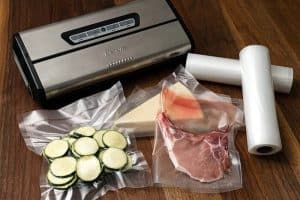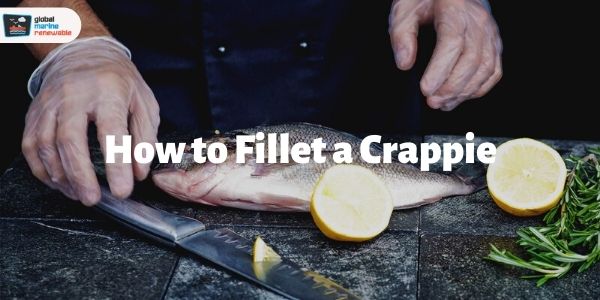Most people don’t realize the benefits of filleting crappie at home. A store-bought or gutted crappie fish contains pathogenic bacteria capable of causing digestive problems.
Most of them are also laced with preservatives.
Table of Contents
How to Clean and Fillet a Crappie – The Basics
Filleting crappie at home is a healthy and informed decision.
Also, whole crappie fish is way cheaper than skinned fillets. This post is intended to inform you about cleaning and filleting a crappie fish.
Equipment Needed to Clean and Fillet a Crappie Fish
1. Fillet Knife
A fillet knife should not be confused for a kitchen knife. A kitchen knife is wide and has a considerable thickness.
On the other hand, a fillet knife is thin and sharp. It is intended to cut the fish meat without leaving any drag on the meat.
When filleting a crappie fish, you must scoop up the flesh without leaving small bits and pieces behind on the spine. A fillet knife can also be used for skinning, scaling, and cutting a crappie fish.
2. Vacuum Sealer

A vacuum sealer is a device that sucks all the excess air from a plastic bag and helps preserve the crappie meat for extended durations.
In a medium-sized vacuum sealing bag, you can place one of two fillets of crappie. It takes about 25-20 seconds to vacuum seal one bag.
In addition to excess air, a vacuum sealer also absorbs all the water or moisture on the fillet.
3. Trash Bucket
Gutting and filleting crappie can create a lot of mess. The waste material such as scales, dead skin, and bones can be safely disposed of in a trash bucket.
A trash bucket is a reusable container that can hold waste materials until the filleting is done. Empty the waste in a garbage bin once you are done filleting.
You can reuse the bucket once it is clean and disinfected.
4. Filleting Glove
Handling a sharp fillet knife is not easy. Some people don’t like to get the smell of fish on their hands as it stays even after a good hand wash.
Good quality filleting gloves can prevent your fingers from injuries resulting from a filleting knife accident. You can have separate gloves for cleaning and filleting. Pick thin gloves for cleaning and thick gloves for filleting.
5. Fillet Board
A fillet board is a utility device for cutting and chopping fish. It is generally constructed with natural wood or PVC material. Some fillet boards are also equipped with a clamp.
You can attach the head of the fish on the clamp (as shown in the image above) and filter without worrying about slippage.
Crappie fish has scales, and hence, it does not remain stable while filleting it on a flat table or a desk. This is where a fillet board comes into the picture.
Suggested Read: Best Fish Finder for Crappie
How to Clean a Crappie Fish: Step-By-Step Instructions
Step 1:
Being a flat-bellied fish, cleaning crappie can be quite challenging. Round-bellied fish such as mackerel, salmon, and trout are easy to clean, especially if you plan to gut the fish before filleting.
The first step is to wash the fish with clean water. Crappie fish contain harmful bacteria on their scales. If not washed, the bacteria can slip into the flesh.
How to Clean and Fillet a Crappie Step 2:
Next, take a filleting knife and begin descaling the crappie fish. Move the knife from tail to its head along the spine. For efficient descaling, it is recommended to use the blunt side of a kitchen knife.
Step 3:
Next, find the pee hole of the crappie (located near the tail) and make a one-inch incision. Insert the knife about 3-4 inches in and remove the knife.
At this point, make sure you are wearing the filleting gloves. With your fingers, pull out the guts and dispose of them in the trash bucket. Now you can clean the insides of the crappie fish.
How to Clean and Fillet a Crappie Step 4:
Some people like to leave the skin on, if you don’t, use the filleting knife to skin the crappie. For precision filleting, I would recommend leaving it on.
You may also enjoy reading our article on cleaning catfish.
How to Fillet a Crappie: Step-By-Step Instructions
Step 1:
Lay the crappie fish on its side on a fillet board. Clamp the head of the fish with the help of the holder. Ensure the dorsal fin is either cut-off or does not interfere with the side in contact with the board.
How to Clean and Fillet a Crappie Step 2:
Take a fillet knife and cut a notch behind the head all the way till the tail.
Do not cut through the spine. You are allowed to make a sawing motion to cut through the meat, but while keeping the knife as close to the spine as possible.
Step 3:
Flip over the fish and perform the same step on this side. Filleting this side will be challenging as you do not have a cushion beneath the spine.
There is always a chance of cutting through the spine, hence be extra cautious.
How to Clean and Fillet a Crappie Step 4:
Finally, you can store the fillets in a vacuum bag and seal them with a vacuum sealer. Some vacuum sealers also come with boosters, so no air or moisture is left inside the bag.
How to Clean and Fillet a Crappie Summary
It is always good to catch the crappie yourself or buy them from a store in its original form.
You indeed have to make efforts to clean the fish and deal with the waste, but the result is fresh crappie fish fillets.
